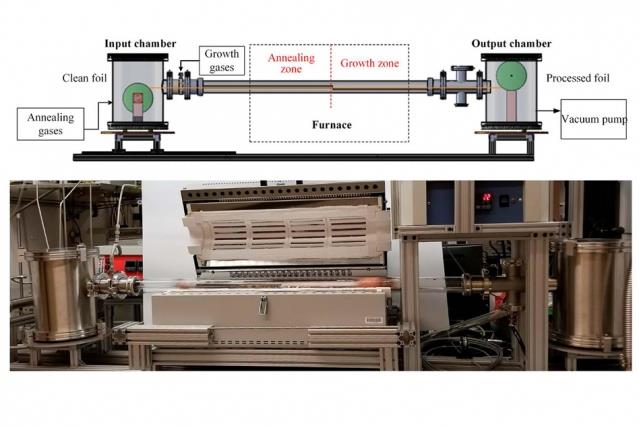John Hart, associate professor of mechanical engineering and director of the Laboratory for Manufacturing and Productivity at MIT, said: “We believe this is the first study that has tailored the manufacturing of graphene toward membrane applications, which require the graphene to be seamless, cover the substrate fully, and be of high quality.”
Graphene-based membranes have mostly been made in small batches in the laboratory, where researchers can carefully control the material’s growth conditions. However, Prof Hart and his colleagues believe that if graphene membranes are ever to be used commercially they will have to be produced in large quantities, at high rates, and with reliable performance.
“We know that for industrialisation, it would need to be a continuous process,” Prof Hart said. “You would never be able to make enough by making just pieces. And membranes that are used commercially need to be fairly big — some so big that you would have to send a poster-wide sheet of foil into a furnace to make a membrane.”
The MIT setup combines a roll-to-roll approach with the common graphene-fabrication technique of chemical vapor deposition. The system consists of two spools, connected by a conveyor belt that runs through a small furnace. The first spool unfurls a long strip of copper foil, less than 1cm wide. When it enters the furnace, the foil is fed first through one tube and then another, in a ‘split-zone’ design.

While the foil rolls through the first tube, it heats up to an ideal temperature, at which point it is ready to roll through the second tube, where the scientists pump in a specified ratio of methane and hydrogen gas, which are deposited onto the heated foil to produce graphene.
“Graphene starts forming in little islands, and then those islands grow together to form a continuous sheet,” Prof Hart explains. “By the time it’s out of the oven, the graphene should be fully covering the foil in one layer, kind of like a continuous bed of pizza.”
As the graphene exits the furnace, it’s rolled onto the second spool. The researchers found that they were able to feed the foil continuously through the system, producing high-quality graphene at a rate of 5cm per minute. Their longest run lasted almost four hours, during which they produced about 10 meters of continuous graphene.
“If this were in a factory, it would be running 24-7,” Prof Hart said. “You would have big spools of foil feeding through, like a printing press.”
The team also ran the process at different speeds, with different ratios of methane and hydrogen gas, and noted the difference in the quality of the resulting graphene after each run. The team is making these results available to other designers looking to identify the setting they would need to produce a certain quality of graphene sheets.
Looking forward, Prof Hart says he would like to find ways to include polymer casting and other steps that are currently performed by hand, in the roll-to-roll system. He said: “For now, we’ve demonstrated that this process can be scaled up, and we hope this increases confidence and interest in graphene-based membrane technologies, and provides a pathway to commercialisation.”





